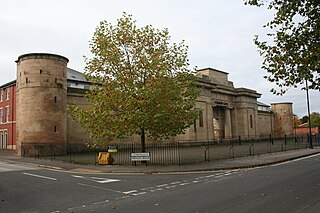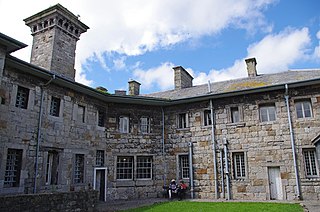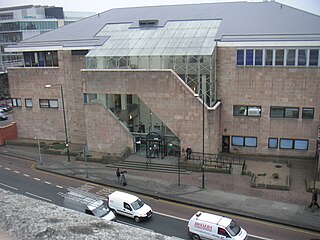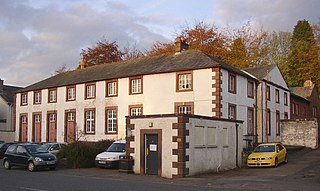In the United Kingdom and Republic of Ireland, a county town is the most important town or city in a county. It is usually the location of administrative or judicial functions within a county, and the place where the county's members of Parliament are elected. Following the establishment of county councils in England 1889, the headquarters of the new councils were usually established in the county town of each county; however, the concept of a county town pre-dates these councils.

Nottinghamshire is a county that is situated in the East Midlands of England. The county has history within the Palaeolithic period, dating anywhere between 500,000 and 10,000 BCE, as well as early Anglo-Saxon communities, dating to 600 CE. Furthermore, the county has significance in the political aspects of English history, particularly within intercommunal fighting, and its economics is historically centred around coal and textiles.

The term Derby Gaol historically refers to the five gaols in Derby, England. Today, the term usually refers to one of two small ‘tourist attractions’, the gaol which stood on Friar Gate from 1756 to 1846 and the cells of which still exist and are open to the public. Their possible location, size and function have been assigned for the attraction, alongside a modern kitchen and bar. The 1843 to 1929 Vernon Street Prison whose frontage can still be seen today, but has been the prison has been redeveloped for modern commercial use.

Nottingham city centre is the cultural, commercial, financial and historical heart of Nottingham, England. Nottingham's city centre represents the central area of the Greater Nottingham conurbation.

Flintham is a village and civil parish in the Rushcliffe district in Nottinghamshire, 7 miles from Newark-on-Trent and opposite RAF Syerston on the A46. It had a population of 597 at the 2011 Census and estimated at 586 in 2019. The village name was taken by the Ham class minesweeper HMS Flintham.

Beaumaris Gaol is a disused gaol located in Beaumaris, Anglesey, Wales. Although no longer in use it remains largely unaltered and is now a museum open to visitors, with around 30,000 visiting each year.

Thomas Chambers Hine was an architect based in Nottingham.

Nottingham Crown Court, or more formally the High Court of Justice and Crown Court, Nottingham is a Crown Court and meeting place of the High Court of Justice on Canal Street in Nottingham, England. The building also accommodates the County Court and the Family Court.

The Shire Hall in Agincourt Square, Monmouth, Wales, is a prominent Grade I listed building in the town centre. It was built in 1724, and was formerly the centre for the Assize Courts and Quarter Sessions for Monmouthshire. In 1839–40, the court was the location of the trial of the Chartist leader John Frost and others for high treason for their part in the Newport Rising. The building was also used as a market place. The Shire Hall is owned by Monmouthshire County Council and has audiovisual guides for visitors to Courtroom 1. It is currently used as a Tourist Information Centre and as the offices for Monmouth Town Council, and is open to the public in part.

High Pavement is a street in Nottingham in Nottinghamshire, England. It is one of the earliest streets in the city, and most of its buildings are listed.

The Sessions House is a former judicial building on George Row in Northampton, England. The Sessions House, which was the main courthouse for Northamptonshire, is currently used as a tourist information centre and is a Grade I listed building. The building is adjacent to County Hall, the meeting place of Northamptonshire County Council.

The Shire Hall is a public building in Stafford, England, completed in 1798 to a design by John Harvey. Formerly a courthouse, it housed an art gallery which closed to the public in July 2017. The court rooms and cells are preserved. The building, its interiors, and the associated street furniture were grade II* listed on 17 December 1971, when it was described as "One of the finest public buildings in Stafford".
Richard Thomas Parker was an English murderer who was the last person to be publicly executed in Nottingham.
The following is a timeline of the history of the city of Nottingham, England.

Shire Hall is a building complex located in Northgate Street in Warwick, England. It is the main office and the meeting place of Warwickshire County Council. The complex is a Grade I listed building.

Nottinghamshire County Hall is a large municipal building located at Loughborough Road on the south bank of the River Trent at West Bridgford in Rushcliffe, Nottinghamshire, England. It is the headquarters of Nottinghamshire County Council which is the upper tier local authority and has jurisdiction across the whole of Nottinghamshire except the City of Nottingham which is administered independently by the unitary authority of Nottingham City Council.

The Old Shirehall was a municipal facility in Market Square, Shrewsbury, Shropshire. It was demolished in 1971 to make way for a retail and commercial centre.

The Shire Hall is a municipal structure in Broad Street, Presteigne, Powys, Wales. The building incorporates a well-preserved courtroom and a museum known as "the Judge's Lodging". Once the judicial centre for Radnorshire, is a Grade II* listed building.

The Shire Hall is a municipal building in The Sands, Appleby-in-Westmorland, Cumbria, England. The shire hall, which is currently used as a dental surgery and business centre, is a Grade II listed building.





















